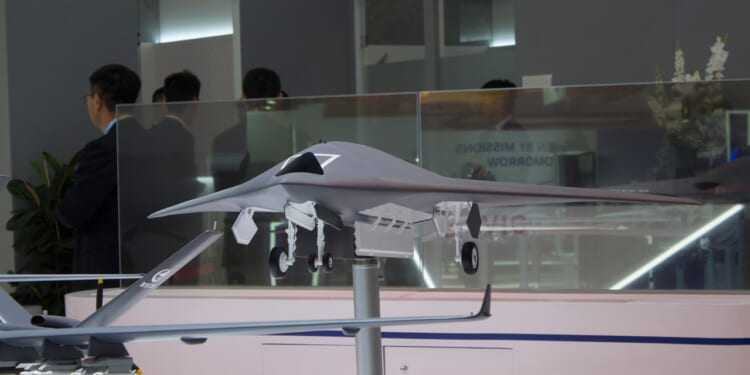The GJ-21 drone’s stealth and autonomy make it ideal for high-threat environments, potentially reshaping naval aviation by allowing operations from drone carriers.
China continues its rapid military expansion and modernization program that has turned its Armed Forces into a real challenger to the US military’s once-unquestioned dominant position in the Indo-Pacific.
One such system showcasing China’s growing military prowess is the GJ-21, a naval variant of China’s Hongdu GJ-11 Sharp Sword, an advanced unmanned combat aerial vehicle (UCAV) designed for stealth operations. This drone represents a serious leap forward in China’s push toward intelligence warfare—particularly in naval aviation, where it could serve as the world’s first operational ship-based stealth combat drone.
The GJ-21’s Specifications
- Year Introduced: 2025 (?)
- Number Built: Unknown; likely low
- Length: 40 ft (12.2 m)
- Wingspan: 47 ft 3 in (14.4 m)
- Weight: Unknown
- Engines: One 4,400-lb Chinese-built turbofan engine; lbf unknown
- Top Speed: Unknown
- Range: Unknown
- Service Ceiling: Unknown
- Loadout: Precision-guided munitions; bombs; two internal weapons bays
- Aircrew: 0 (drone)
A tailless flying-wing configuration optimized for stealth, the GJ-21 has serrated weapon bay doors and rear airframe shaping to minimize radar signature around the engine exhaust. Key naval adaptations include folding wings for compact storage on ships and an updated engine nozzle with enhanced details for better performance and stealth. It is powered by a single unnamed Guizhou-built turbofan engine.
The GJ-21 will be used to conduct precision strikes, aerial reconnaissance, and electronic warfare (EW) for China’s People’s Liberation Army Navy (PLAN). It can also deploy swarming air-launched decoys, EW systems, or munitions from its internal bays to maintain stealth. And, as a “Loyal Wingman,” the bird integrates with manned aircraft, like the two-seat Chengdu J-20S, where up to three drones can be controlled for collaborative missions.
The GJ-21 Drone’s History
Developed by the Hongdu Aviation Industry Group (a subsidiary of the Aviation Industry Corporation of China), the GJ-21 builds on the GJ-11’s flying-wing design but incorporates modifications like folding wings to better enable carrier-based operations (it needs to fit into the cramped hangar of a carrier).
The Sharp Sword program began in 2009 as a stealth drone project under the Shenyang Aircraft Corporation, with the GJ-11 as the initial model. The prototype made its maiden flight in November 2013, lasting about 20 minutes.
Early versions had less refined stealth features, such as an exposed engine nozzle, but iterations improved low observability. The GJ-11 was publicly unveiled at China’s 2019 National Day Parade and showcased at Airshow China in 2021.
By 2021, it was in testing and evaluation, with serial production planned for 2022.
China’s efforts to integrate UCAVs with China’s growing fleet of aircraft carriers is what led to the naval-focused GJ-21 variant. This naval UCAV was prominently featured at the eightieth anniversary of the end of the Second World War in China’s Victory Parade in Beijing. Two airframes, numbered 21 and 22, were present, though only one participated in the parade—suggesting these might be operational units rather than mockups.
Reports confirm a GJ-21 flew autonomously to Beijing for the event.
The design has been linked to the Type 076 amphibious assault ship (informally referred to as a “drone carrier”), with its emblem featuring a similar wing profile and electromagnetic catapult for launches.
The GJ-21 Is Key to China’s Naval War Plans
In naval contexts, the GJ-21 enhances China’s carrier strike groups. Its stealth and autonomy make it ideal for high-threat environments, potentially reshaping naval aviation by allowing operations from drone carriers.
Because the GJ-21 flew autonomously to Beijing for the Victory Parade on September 3, many experts assess that the drone is actively deployed. Indeed, it is part of China’s broader UCAV ecosystem, including other collaborative combat aircraft (CCA), like the FH-97A, aimed at extending China’s reach into the Pacific.
China is a real challenger to the United States. The GJ-21 is just one of many systems that should keep US defense planners up at night.
About the Author: Brandon J. Weichert
Brandon J. Weichert is a senior national security editor at The National Interest. Recently, Weichert became the host of The National Security Hour on America Outloud News and iHeartRadio, where he discusses national security policy every Wednesday at 8pm Eastern. He is also a contributor at Popular Mechanics and has consulted regularly with various government institutions and private organizations on geopolitical issues. Weichert’s writings have appeared in multiple publications, including The Washington Times, National Review, The American Spectator, MSN, The Asia Times, and others. His books include Winning Space: How America Remains a Superpower, Biohacked: China’s Race to Control Life, and The Shadow War: Iran’s Quest for Supremacy. His newest book, A Disaster of Our Own Making: How the West Lost Ukraine is available for purchase wherever books are sold. He can be followed via Twitter @WeTheBrandon.
Image: Shutterstock / Aerospace Trek.


















